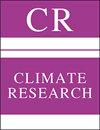统计降尺度模型的相互比较:以大尺度流域为例
IF 1.6
4区 地球科学
Q4 ENVIRONMENTAL SCIENCES
引用次数: 2
摘要
局部尺度的气候变化评估需要使用各种方法降低大气环流模式(GCMs)的尺度。在本研究中,使用已建立的机器学习技术的统计降尺度与提出的极端梯度增强决策树(EXGBDT)技术进行了比较。印度半岛南部的高韦里河流域以频繁的干旱和洪水而闻名,在这项研究中被考虑在内。利用研究区35个台站的日观测资料,利用ACCESS 1.0 CMIP5历史GCM模拟对局地气候进行了降尺度化。对高韦里河上游、中部和下游流域的降水和平均、最高和最低温度等日常天气变量的模式性能进行了相互比较。研究结果表明,提出的EXGBDT模型的均值方差约为15%,偏差可以忽略不计,优于其他考虑的模型。训练和测试期间的NSE和R2值范围为0.75-0.85。不同子流域和参数的观测月均值与降尺度数据的月均值对比表明,模型效率更高。与CLIMDEX指数的比较方差较小,说明EXGBDT模型能更好地反映局部气候条件。本文章由计算机程序翻译,如有差异,请以英文原文为准。
Intercomparison of statistical downscaling models: a case study of a large-scale river basin
Climate change assessment at a local scale requires downscaling of general circulation models (GCMs) using various approaches. In this study, statistical downscaling using established machine learning techniques is compared with the proposed extreme gradient boosting decision tree (EXGBDT) technique. The Cauvery river basin in southern peninsular India, which is known for its frequent droughts and floods, was considered in this study. The ACCESS 1.0 CMIP5 historical GCM simulation was used for downscaling the local climate with the help of daily observation data from 35 stations located in the study zone. An intercomparison of model performance in predicting daily weather variables such as precipitation and average, maximum, and minimum temperatures over the upper, middle, and lower Cauvery river basin was performed. The findings show that mean-variance is around 15% and bias is negligible for the proposed EXGBDT model, which is better than other models under consideration. The NSE and R2 values range from 0.75-0.85 for both training and testing periods. The intercomparison of monthly mean values of observed and downscaled data for different sub-basins and parameters suggests higher model efficiency. The lower variance observed in the comparison of CLIMDEX indices suggests that the EXGBDT model performance is better in representing the local climatic condition.
求助全文
通过发布文献求助,成功后即可免费获取论文全文。
去求助
来源期刊

Climate Research
地学-环境科学
CiteScore
2.90
自引率
9.10%
发文量
25
审稿时长
3 months
期刊介绍:
Basic and applied research devoted to all aspects of climate – past, present and future. Investigation of the reciprocal influences between climate and organisms (including climate effects on individuals, populations, ecological communities and entire ecosystems), as well as between climate and human societies. CR invites high-quality Research Articles, Reviews, Notes and Comments/Reply Comments (see Clim Res 20:187), CR SPECIALS and Opinion Pieces. For details see the Guidelines for Authors. Papers may be concerned with:
-Interactions of climate with organisms, populations, ecosystems, and human societies
-Short- and long-term changes in climatic elements, such as humidity and precipitation, temperature, wind velocity and storms, radiation, carbon dioxide, trace gases, ozone, UV radiation
-Human reactions to climate change; health, morbidity and mortality; clothing and climate; indoor climate management
-Climate effects on biotic diversity. Paleoecology, species abundance and extinction, natural resources and water levels
-Historical case studies, including paleoecology and paleoclimatology
-Analysis of extreme climatic events, their physicochemical properties and their time–space dynamics. Climatic hazards
-Land-surface climatology. Soil degradation, deforestation, desertification
-Assessment and implementation of adaptations and response options
-Applications of climate models and modelled future climate scenarios. Methodology in model development and application
 求助内容:
求助内容: 应助结果提醒方式:
应助结果提醒方式:


